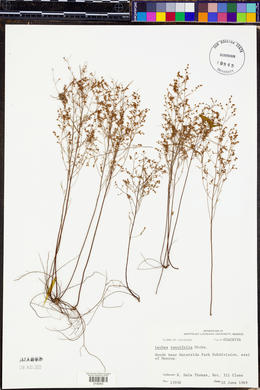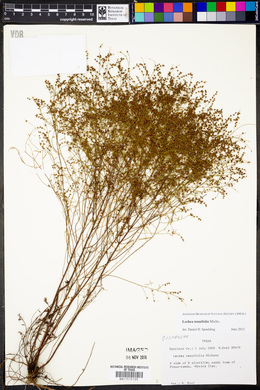Lechea tenuifolia
|
|
|
|
Family: Cistaceae
Narrow-Leaf Pinweed, more...narrowleaf pinweed
[Lechea tenuifolia var. occidentalis Hodgdon, moreLechea tenuifolia var. tenuifolia] |
Perennial herb 10 - 40 cm tall Leaves: not many and falling early, scattered, alternate, stalkless, bright green, small, very narrow (about 1 mm wide), 0.8 - 2 cm long, ten or more times longer than wide, linear or threadlike, non-toothed, one-nerved, hairless above, but with sparse hairs on underside. The leaves on the later produced basal shoots differ from the upright stem leaves by being more numerous, much more crowded, and only 3 - 6 mm long. Inflorescence: terminal, long (over half height of plant), slightly open, somewhat elliptic in outline, rather delicate, finely leafy, with many, ascending to almost spreading branches. At the end of the inflorescence branches are loose, short, often one-sided, spike-like clusters of short-stalked, tiny (up to 3 mm tall), reddish, non-showy, radially symmetric flowers. Sepals: five, but in two series, with outer two green, linear, much narrower, 2 - 3 mm long, and usually a bit longer than the dull green, 1.6 - 1.9 mm tall, broadly egg-shaped inner three. All five sepals are obviously hairy and longer than the petals, and the inner three sepals have a conspicuous midvein, but never a raised lengthwise ridge (keel) as in some species. Petals: three, mostly concealed by sepals, reddish, small, and rarely expanding. Stamens: typically five to twenty, with short anthers on relatively long, slender filaments. Pistil: with one, single-chambered, superior ovary; no style; but three, feather-like stigmas. Fruit: single-chambered, three-valved, 1.3 - 1.5 mm tall, broadly egg-shaped to nearly spheric capsules which are enclosed by the persistent sepals, and sit on stalks shorter than 2 mm. Stems: one to several, erect, unbranched below inflorescence, very slender, and very sparsely covered with ascending or erect hairs. Late in the season producing slender basal shoots up to 7 cm long, with numerous, crowded leaves. Seeds: two to five per capsule, yellowish to reddish brown, opaque, plump, 0.7 - 1 mm long, and released when top of capsule opens down the three lengthwise valves. Similar species: Lechea tenuifolia is most similar to L. minor, but that species has broader leaves (at least 2 mm wide), the outer sepals are normally much longer than the inner sepals, the inner sepals may have a shallow lengthwise ridge on their outer side, and the tip of the capsule normally extends a bit above the sepals in fruit. Also similar is L. mucronata, except that species has spreading hairs on the stem, the leaves are much wider, the outer sepals are often shorter (never longer) than the inner three sepals, and the mostly hairless inner sepals have a greenish, rough, obviously raised, lengthwise ridge (keel) running down their outer side. Some individuals of L. racemulosa may appear similar, but normally the fruit stalks are more than 2 mm long, and the outer sepals are never longer than the inner sepals. Flowering: July to September Habitat and ecology: Occasionally found in dry sandy habitats such as black oak savannas in the more southern counties of the Chicago Region. Occurence in the Chicago region: native Etymology: Lechea is named after John Leche (1704 - 1764), a Swedish botanist. Tenuifolia comes from the Latin words tenuis, meaning thin, fine, or delicate, and folia, meaning leaves, and thus together meaning thin leaves. Author: The Field Museum Stems 1-3 dm, with a few erect or ascending hairs; lvs of basal shoots linear, crowded, 3-6 mm; cauline lvs linear or filiform, to 2 cm, usually under 1(-1.5) mm wide and at least 10 times as long as wide, sparsely hairy only beneath, soon deciduous; panicle occupying half the plant or more, its numerous branches often racemiform and secund; inner sep concave, with a conspicuous midvein but not keeled, hairy over mostof or all the surface; outer sep linear, usually distinctly exceeding the inner; fr broadly ovoid to subglobose, usually slightly shorter than and enclosed by the cal. Dry soil, upland woods, and barrens; s. Me. to S.C., chiefly near the coast; Minn. to Ind., s. and sw. to Miss. and Tex. A more robust and more hairy form, chiefly to the w. and sw. of our range, but also in nw. Ill., has been segregated as var. occidentalis Hodgdon. Gleason, Henry A. & Cronquist, Arthur J. 1991. Manual of vascular plants of northeastern United States and adjacent Canada. lxxv + 910 pp. ©The New York Botanical Garden. All rights reserved. Used by permission. From Flora of Indiana (1940) by Charles C. Deam In poor soil on the crests and slopes of black and white and chestnut oak ridges in the southern part of the state and in dry or moist, sandy soil in pin oak woods and on the dunes in the northern part. …… Indiana Coefficient of Conservatism: C = 4 Wetland Indicator Status: N/A |








































































